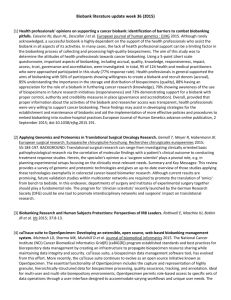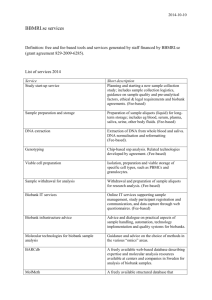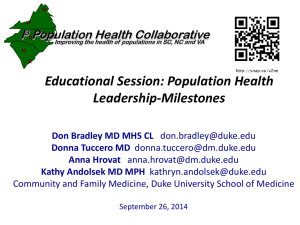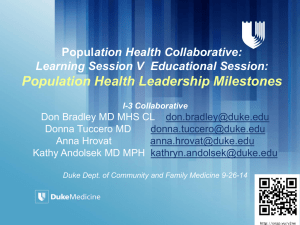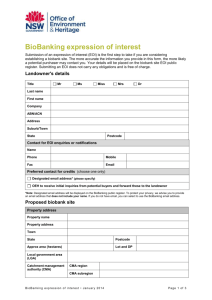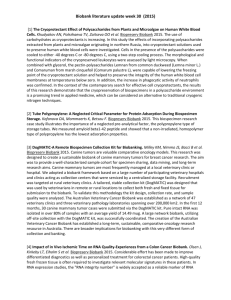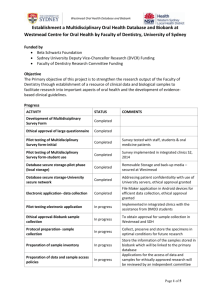poster - Duke Center for Health Informatics
advertisement
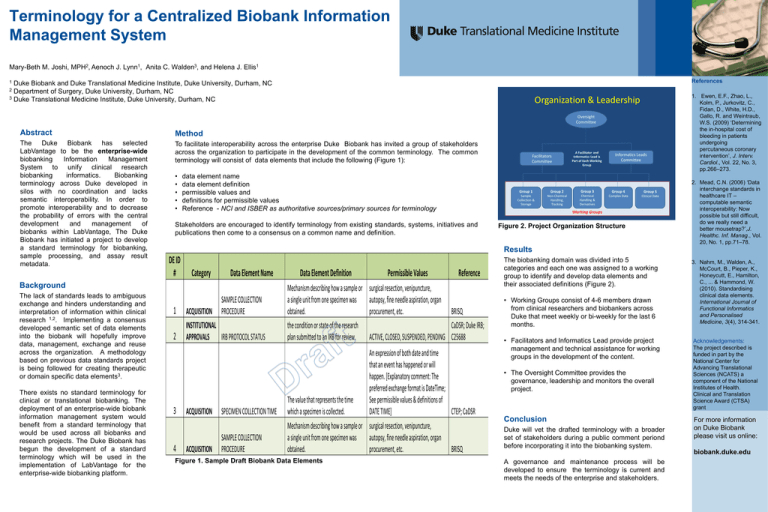
Terminology for a Centralized Biobank Information Management System Mary-Beth M. Joshi, MPH2, Aenoch J. Lynn1, Anita C. Walden3, and Helena J. Ellis1 References 1 Duke Biobank and Duke Translational Medicine Institute, Duke University, Durham, NC 2 Department of Surgery, Duke University, Durham, NC 3 Duke Translational Medicine Institute, Duke University, Durham, NC Organization & Leadership Oversight Committee Abstract Method The Duke Biobank has selected LabVantage to be the enterprise-wide biobanking Information Management System to unify clinical research biobanking informatics. Biobanking terminology across Duke developed in silos with no coordination and lacks semantic interoperability. In order to promote interoperability and to decrease the probability of errors with the central development and management of biobanks within LabVantage, The Duke Biobank has initiated a project to develop a standard terminology for biobanking, sample processing, and assay result metadata. To facilitate interoperability across the enterprise Duke Biobank has invited a group of stakeholders across the organization to participate in the development of the common terminology. The common terminology will consist of data elements that include the following (Figure 1): • • • • • data element name data element definition permissible values and definitions for permissible values Reference - NCI and ISBER as authoritative sources/primary sources for terminology There exists no standard terminology for clinical or translational biobanking. The deployment of an enterprise-wide biobank information management system would benefit from a standard terminology that would be used across all biobanks and research projects. The Duke Biobank has begun the development of a standard terminology which will be used in the implementation of LabVantage for the enterprise-wide biobanking platform. Informatics Leads Committee Group 1 Group 2 Group 3 Group 4 Group 5 Sample Collection & Storage Non-Chemical Handling, Tracking Chemical Handling & Derivatives Complex Data Clinical Data Working Groups Stakeholders are encouraged to identify terminology from existing standards, systems, initiatives and publications then come to a consensus on a common name and definition. Figure 2. Project Organization Structure 2. Mead, C.N. (2006) ‘Data interchange standards in healthcare IT – computable semantic interoperability: Now possible but still difficult, do we really need a better mousetrap?’,J. Healthc. Inf. Manag., Vol. 20, No. 1, pp.71–78. Results DE ID # Category Data Element Name Background The lack of standards leads to ambiguous exchange and hinders understanding and interpretation of information within clinical research 1,2. Implementing a consensus developed semantic set of data elements into the biobank will hopefully improve data, management, exchange and reuse across the organization. A methodology based on previous data standards project is being followed for creating therapeutic or domain specific data elements3. Facilitators Committee A Facilitator and Informatics Lead is Part of Each Working Group 1. Ewen, E.F., Zhao, L., Kolm, P., Jurkovitz, C., Fidan, D., White, H.D., Gallo, R. and Weintraub, W.S. (2009) ‘Determining the in-hospital cost of bleeding in patients undergoing percutaneous coronary intervention’, J. Interv. Cardiol., Vol. 22, No. 3, pp.266–273. 1 2 SAMPLE COLLECTION ACQUISITION PROCEDURE INSTITUTIONAL APPROVALS IRB PROTOCOL STATUS 3 ACQUISITION SPECIMEN COLLECTION TIME 4 SAMPLE COLLECTION ACQUISITION PROCEDURE Data Element Definition Permissible Values Mechanism describing how a sample or a single unit from one specimen was obtained. the condition or state of the research plan submitted to an IRB for review. surgical resection, venipuncture, autopsy, fine needle aspiration, organ procurement, etc. The value that represents the time which a specimen is collected. BRISQ CaDSR; Duke IRB; ACTIVE, CLOSED, SUSPENDED, PENDING C25688 An expression of both date and time that an event has happened or will happen. [Explanatory comment: The preferred exchange format is DateTime; See permissible values & definitions of DATE TIME] CTEP; CaDSR Mechanism describing how a sample or surgical resection, venipuncture, a single unit from one specimen was autopsy, fine needle aspiration, organ obtained. procurement, etc. Figure 1. Sample Draft Biobank Data Elements Reference BRISQ The biobanking domain was divided into 5 categories and each one was assigned to a working group to identify and develop data elements and their associated definitions (Figure 2). • Working Groups consist of 4-6 members drawn from clinical researchers and biobankers across Duke that meet weekly or bi-weekly for the last 6 months. • Facilitators and Informatics Lead provide project management and technical assistance for working groups in the development of the content. • The Oversight Committee provides the governance, leadership and monitors the overall project. Conclusion Duke will vet the drafted terminology with a broader set of stakeholders during a public comment periond before incorporating it into the biobanking system. 3. Nahm, M., Walden, A., McCourt, B., Pieper, K., Honeycutt, E., Hamilton, C., ... & Hammond, W. (2010). Standardising clinical data elements. International Journal of Functional Informatics and Personalised Medicine, 3(4), 314-341. Acknowledgements: The project described is funded in part by the National Center for Advancing Translational Sciences (NCATS) a component of the National Institutes of Health. Clinical and Translation Science Award (CTSA) grant For more information on Duke Biobank please visit us online: biobank.duke.edu A governance and maintenance process will be developed to ensure the terminology is current and meets the needs of the enterprise and stakeholders.
